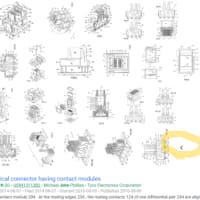WO2015183659(特表2017-518050)
(Ab)
"In the present invention, a method and assay for the detection of proteases and protease inhibitors using colloidal gold nanoparticles and peptide substrates, which are selectively recognized and cleaved by proteases being assayed, is disclosed. In this assay, the mechanism of signal generation relies on peptide sequence induced aggregation(凝集)of gold nanoparticles, which are used as signal reporters. The peptide sequences that induce aggregation are either the intact peptide substrates or proteolytic fragments of the intact peptide substrate wherein the proteolytic fragments are produced by the protease being assayed. The present invention provides a novel, simple, sensitive, and inexpensive colloidal gold nanoparticle-based colorimetric assay that allows both visual and quantitative detection of proteases and protease inhibitors."
WO2012076853(特表2014-504316)
(Ab)
"The application discloses methods of processing particulate carbon material, such as graphitic particles or agglomerates(凝集物)of carbon nanoparticles such as CNTs. The starting material is agitated in a treatment vessel in the presence of low-pressure (glow) plasma generated between electrodes, e.g. between a central electrode and an outer rotating conductive drum containing the material for treatment. Preferably the material is agitated in the presence of conductive contact bodies(接触体)such as metal balls, or other contact formations with relatively high specific surface area, on the surface of which plasma glow is present and amongst which the material to be treated moves. The methods are found to effectively deagglomerate(解凝集)nanoparticles, and to exfoliate graphitic material to produce very thin (few- layer or monolayer) graphitic sheets showing graphene-type characteristics. The resulting deaggregated or exfoliated carbon nanomaterials are an aspect of the disclosure, as is their use dispersed in composite materials, e.g. conductive polymeric composites for electric or electronic articles and devices. The particle surfaces can be functionalised(官能化)by choosing appropriate gas in which to form the plasma. The invention is advantageous in using safe, dry and moderate conditions to achieve a high degree of deaggregation or exfoliation compared with previous aggressive chemical methods such as acid treatment."
WO2011137005(特表2013-530064)
"1. A coated article comprising a substrate surface, a nanoparticle-containing primer disposed on the substrate surface, and a silicone-based(シリコーン系)material bonded to the nanoparticle-containing primer, wherein the nanoparticle-containing primer comprises(含み)agglomerates(凝集体)of silica nanoparticles, said agglomerates comprising a three-dimensional porous network of silica nanoparticles, and the silica nanoparticles being bonded to adjacent silica nanoparticles."
WO2009126571(特表2011-517604)
"7. The method of claim 4 wherein the functional coating comprises a material that promotes nanoparticle aggregation(凝集)within the cell or tissue of interest(目的の)."
最新の画像[もっと見る]
-
 DAZN(ダゾーン):メール配信停止ボタンくらい付けとけ
5日前
DAZN(ダゾーン):メール配信停止ボタンくらい付けとけ
5日前
-
 DAZN(ダゾーン):メール配信停止ボタンくらい付けとけ
5日前
DAZN(ダゾーン):メール配信停止ボタンくらい付けとけ
5日前
-
 バズリクソンズA2:第15週
1週間前
バズリクソンズA2:第15週
1週間前
-
 バズリクソンズA2:第14週
2週間前
バズリクソンズA2:第14週
2週間前
-
 Google Patents Advanced Searchで全部表示される図面の表示を隠す
2週間前
Google Patents Advanced Searchで全部表示される図面の表示を隠す
2週間前
-
 召合せ框(めしあわせかまち)
3週間前
召合せ框(めしあわせかまち)
3週間前
-
 バズリクソンズA2:第13週
3週間前
バズリクソンズA2:第13週
3週間前
-
 バズリクソンズA2:第13週
3週間前
バズリクソンズA2:第13週
3週間前
-
 バズリクソンズA2:第13週
3週間前
バズリクソンズA2:第13週
3週間前
-
 バズリクソンズA2:第12週
4週間前
バズリクソンズA2:第12週
4週間前
















※コメント投稿者のブログIDはブログ作成者のみに通知されます